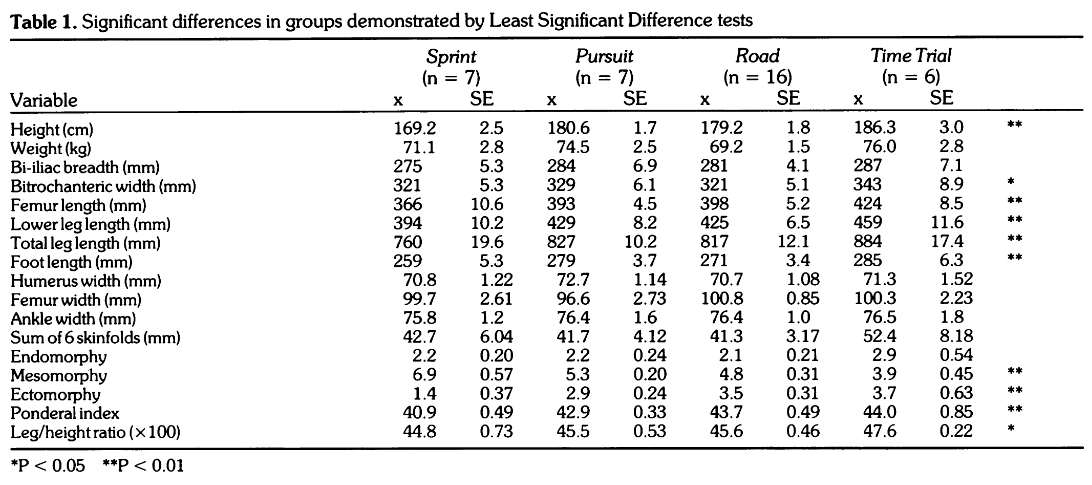Cycling Findings #1a
Interesting research from the cycling science literature
Anthropometric comparison of cyclists from different events Foley, Bird and White, 1989
Whether you're a serious cyclist, a novice or simply prefer watching others do the suffering, you're probably aware that, although clearly an endurance sport, different types of cycling suit different types of rider. Even the casual fan knows that there are climbers, sprinters and time trialists.
Obviously, there are certain essential characteristics that are shared by all strong riders and there is a large overlap between the categories, but nevertheless there are specific physical traits that predispose a rider to excel in one discipline relative to the others. Some of these traits are based on unchangeable skeletal features.
This study looked at this, based on rider specialization. Riders were placed into one of four categories based on their strengths: sprint (track and road), pursuit, time trial (including ultra distance) and all-rounders. The most significant differences between the groups were found in height, femur, lower leg and total leg lengths, foot length and somatotype (the ratio of endomorphy, mesomorphy and ectomorphy).
In all cases, the sprinters had the lowest values, i.e. they were the shortest in stature, leg and foot measurements and were the most mesomorphic (muscular). The time trial specialists were the tallest with the greatest leg and foot measurements and highest ectomorphy (slenderness). The pursuit and all-round riders were intermediate.

These results were consistent with earlier studies. They were explained in light of the crucial importance of strength and cadence in sprinting, respectively facilitated by a relatively muscular physique and short legs. In contrast, for time trial riding a more effective approach is to push a large gear at a relatively low cadence, so therefore there could be mechanical advantage to having longer legs and a leaner body frame.
This is quite an old study, and I failed to find any more recent follow-ups, which is a shame because I'd love to see a larger, more comprehensive analysis.
For what it's worth, I followed the authors' methods on myself which emphatically placed me in the sprinter category. This didn't come as a surprise, as (although I've never done a proper power profile test) I'm clearly stronger at short efforts relative to longer ones. Does this mean I should use this as an excuse to cut out the long rides, and just focus on intervals and pumping iron? Of course not; cycling is an endurance sport, and even short criterium races demand a lot of endurance; there's no point having a devastating sprint if you're too tired to produce it at the end of an actual race.
What it might do is give me more confidence that the specialization phases of my training should indeed be focused on power and top end speed and that my best chance for good results will be in criteriums as opposed to long road races or hill climbs. But my overall training plan should be quite similar to any other amateur cyclist, just with a different emphasis.